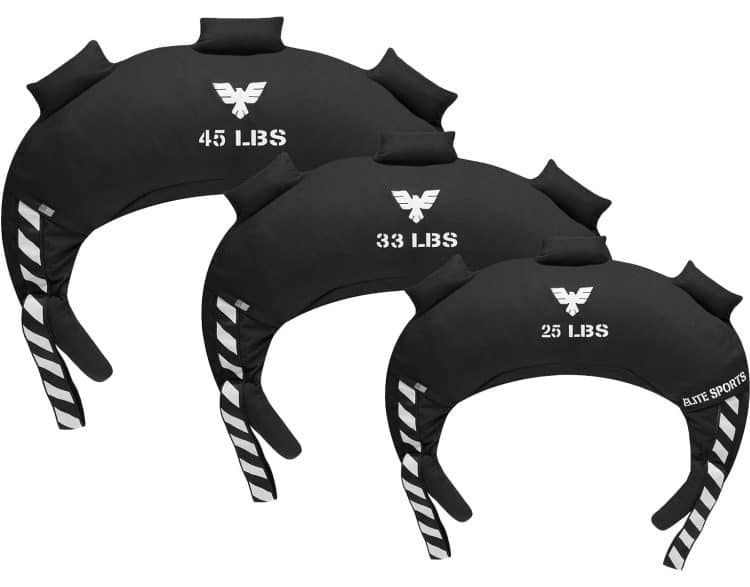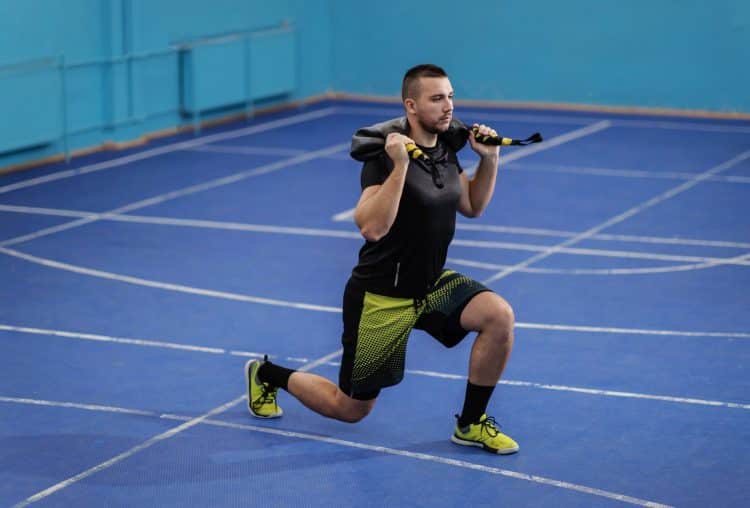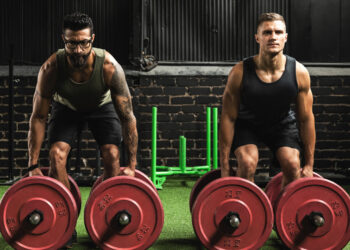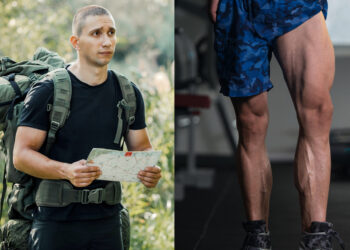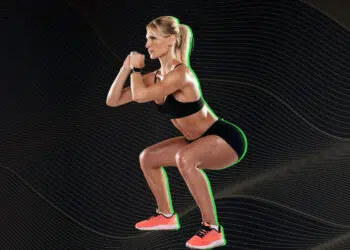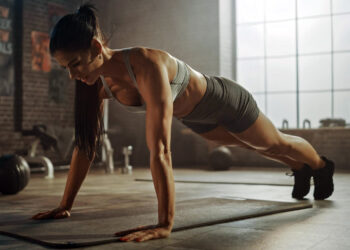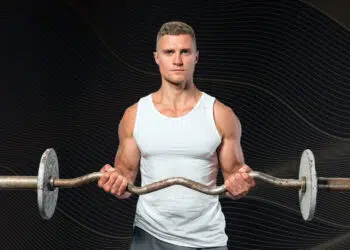I’ve been helping people get fit, build muscle, and lose weight for over 30 years. During that time, I’ve tried just about every exercise tool you can think of, from the common to the more unusual.
That’s because, unlike many personal trainers, I don’t believe there is a single training method that’s perfect for everyone or every goal. Subsequently, I’m not a calisthenics guy, a kettlebell guy, an Olympic lifting guy, or a suspension trainer guy.
Instead, I use ALL these tools to get my clients and myself into great shape. In this, I follow legendary martial artist and movie star Bruce Lee’s philosophy: Absorb what is useful, reject what is useless, and add what is essentially your own.
One of the more unusual training tools I use is Bulgarian bags. Bulgarian bags are functional, effective, and fun, and there are some great exercises you can do with them. Studies also support their use, suggesting they can be effective tools for improving various aspects of fitness and performance (1).
In this article, I reveal the benefits and advantages of Bulgarian bag training and share a few of my favorite exercises.
Level Up Your Fitness: Join our 💪 strong community in Fitness Volt Newsletter. Get daily inspiration, expert-backed workouts, nutrition tips, the latest in strength sports, and the support you need to reach your goals. Subscribe for free!
What is a Bulgarian Bag?
A Bulgarian bag is a crescent or yoke-shaped exercise tool used in functional strength and conditioning workouts. They’re usually made of canvas or leather and come in a range of weights, from about ten pounds to 50.
Most contain sand, gravel, or some other form of flexible weight. They’re also padded to make them flexible and comfortable to use. In many ways, Bulgarian bags are similar to sandbags and kettlebells.
Typically used singularly, Bulgarian bags have several handles so they can be lifted and swung in numerous ways. They can be used for upper and lower body training, and most Bulgarian bag exercises involve your core.
Bulgarian bags were invented in the early 2000s by former Bulgarian wrestler and US Olympic wrestling coach Ivan Ivanov. He was inspired after watching Bulgarian shepherds lift and carry lambs and sheep on their shoulders. If you squint and use your imagination, you may be able to see that Bulgarian bags are sort of animal-shaped!
Ivanov designed his Bulgarian bags as a training tool for elite wrestlers. However, they’ve since been adopted by the mainstream fitness industry and marketed as a functional training tool.
While you can buy Bulgarian bags for personal use, gyms often have them, too. That’s good news because Bulgarian bags can be expensive, especially the heavier models. Alternatively, you can make your own for just a few dollars, such as this one:
The Benefits and Advantages of Bulgarian Bag Training
Is Bulgarian bag training worth your time and energy? Consider these benefits and advantages and then decide!
Increase Muscular Power and Endurance
While you probably won’t build slabs of new muscle with a Bulgarian bag, your muscular power and endurance will definitely increase.
Power is your ability to generate force quickly. Many Bulgarian bag exercises are performed explosively, which means rapid movements followed by equally quick changes in direction. This form of training is called plyometrics and is one of the most effective ways to increase power. Power is a critical part of most sports, e.g., when kicking, punching, jumping, or throwing.
In contrast, endurance is your ability to resist fatigue. It’s typically developed through high reps using light to moderate loads with short rests between sets. This describes many of the exercises you can do with a Bulgarian bag.
Rotational Power and Strength
Bulgarian bag exercises often involve rotation or twisting. These movements build rotational and anti-rotational power and strength by targeting your core muscles. Rotational power and strength are a big part of most sports, especially those involving throwing, kicking, and punching. Even running involves an element of rotational power and strength.
Multi-Planar Movements
Most strength and conditioning exercises occur in the sagittal plane, i.e., they involve forward and backward movements. Examples of sagittal plane exercises include squats, lunges, deadlifts, bench presses, push-ups, rows, and biceps curls.
However, there are two more planes of motion – the frontal and transverse planes. Because they can be lifted and swung in multiple directions, you can use a Bulgarian bag to train in all three planes and not just forward and backward. This will enhance function and athleticism.
A Stronger Grip
Bulgarian bags have several different grips, all of them quite unlike barbells, dumbbells, or resistance machine handles. This makes them somewhat awkward to hold, especially during high-speed swings.
Grip strength is critical in contact and combat sports, and having a solid grip will enhance your performance in pulling exercises like deadlifts, pull-ups, rows, and curls. Bulgarian bag training develops all types of grip strength, including crush, pinch, and support. Expect your forearms to feel pumped after your first Bulgarian bag workout.
Improved Cardiovascular Fitness
Bulgarian bag training is a great way to improve muscular endurance and power. However, you can also use this training tool to enhance your cardiovascular fitness.
Most Bulgarian bag exercises involve multiple muscle groups. These exercises demand lots of oxygenated blood, so your heart and breathing rate will quickly increase to provide your muscles with what they need.
As such, a high rep set of, e.g., Bulgarian bag swings or snatches will leave you out of breath and cardiovascularly challenged. Do several Bulgarian bag exercises back-to-back, and you have an excellent cardio workout without resorting to things like jogging or jumping rope.
Level Up Your Fitness: Join our 💪 strong community in Fitness Volt Newsletter. Get daily inspiration, expert-backed workouts, nutrition tips, the latest in strength sports, and the support you need to reach your goals. Subscribe for free!
Bulgarian bag exercises work especially well as part of a circuit or HIIT training, e.g., Tabata workouts.
Sports-Specific Workout
Bulgarian bags were invented for sports-specific training. As such, the Bulgarian Bag is a very effective training tool for many sports, including but not limited to:
- Baseball
- Basketball
- Football
- Golf
- Gymnastics
- Hockey
- Martial arts
- Rock climbing
- Rugby
- Soccer
- Tennis
- Volleyball
Training with a Bulgarian bag will develop your fitness, endurance, and power while strengthening your core and grip. Bulgarian bag exercises train your entire body, which enhances functionality and athleticism. So, whatever sport you play, Bulgarian bag training will improve your strength and conditioning.
Training Versatility
There is no limit to how you can incorporate Bulgarian bags into your workouts. You can lift them like conventional weights, swing them like kettlebells, throw them like medicine balls, or use them to load bodyweight exercises, such as lunges, push-ups, and squats.
If you want to create a minimalist home gym where you can do a wide variety of exercises with the least amount of equipment, a few Bulgarian bags would be an excellent option.
A User-Friendly, Floor-Safe Workout
While barbells, dumbbells, and kettlebells are great training tools, they can be dangerous. Drop one on your toe or head, and severe injury will likely result. Dropping an iron weight on the floor will probably damage it unless you put down protective matting.
Bulgarian bags are a much safer option. They’re soft and flexible, making them less likely to cause injury or damage your floor or feet when dropped. As such, they’re a viable option for home workouts where metal weights would be impractical or dangerous.
Example Bulgarian Bag Exercises
There are hundreds of Bulgarian bags to try, so it’s beyond the scope of this article to provide you with a definitive list of movements for your workouts. That said, here are three classic Bulgarian bag exercises to get you started.
1. Bulgarian Bag Halo
Muscles targeted: Deltoids, forearms, core.
The halo is the foundation of many Bulgarian bag exercises. Unlike kettlebell halos, which are predominately a mobility exercise, you do this movement quickly to develop core strength and shoulder power. Holding on tight means your forearms and grip will also get a good workout. This rotational exercise is ideal for athletes from all sports.
How to do it:
- Stand with your feet shoulder-width apart, knees slightly bent. Hold your Bulgarian bag in front of your legs by the end handles. Pull your shoulders down and back, and brace your core.
- Putting your whole body into the movement, swing your Bulgarian bag across the front of your body and overhead to make a circle.
- Continue circling the bag in the same direction for the required number of reps
- Repeat in the opposite direction.
Tips:
- Increase your speed to make this exercise more challenging.
- Use the built-in wrist straps to deemphasize your grip and focus more on rotational core and shoulder power.
- Keep your core braced and squeeze your glutes to stabilize your hips and core and avoid being pulled off balance.
2. Bulgarian Bag Snatch
Muscles targeted: Gluteus maximus, hamstrings, core, deltoids, forearms.
The snatch is an explosive exercise typically performed using a barbell, dumbbells, or kettlebell. It’s one of the official disciplines in Olympic weightlifting and a very challenging exercise to master. The Bulgarian bag snatch works most of the same muscles, but it is much easier to learn, considerably safer, and far more forgiving.
How to do it:
- Stand with your feet shoulder-width apart, knees slightly bent.
- Hold your Bulgarian bag in front of your legs by the end handles. Pull your shoulders down and back, and brace your core.
- Hinge forward from your hips, bend your legs, and lower your Bulgarian bag between your knees.
- Drive your hips forward, extend your knees, and swing the weight up and overhead to arm’s length.
- Return to the starting position and repeat.
Tips:
- While it’s impossible not to use your arms during this exercise, most of your power should come from your hips and legs. Use your arms as little as possible, i.e., don’t curl and press the weight up.
- Keep your core tight, and do not round your lower back, as doing so can lead to injury.
- Stabilize your Bulgarian bag overhead before lowering it and starting your next rep.
3. Bulgarian Bag Arm Throw
Muscles targeted: Deltoids, quadriceps, gluteus maximus, core, biceps, triceps, forearms.
Ivan Ivanov invented Bulgarian bags for wrestlers, and no exercise suits that purpose more than the Bulgarian bag arm throw. This rotational exercise mimics throwing an opponent over your shoulder. However, this move isn’t just good for wrestlers; it’s a full-body exercise that every lifter will benefit from.
How to do it:
- Stand with your feet shoulder-width apart, knees slightly bent.
- Hold your Bulgarian bag in front of your legs by the end handles. Pull your shoulders down and back, and brace your core.
- Swing your Bulgarian bag across your body and onto your upper back.
- Bend your knees and drop into a squat to absorb the impact.
- Stand up and pop the bag off your upper back and into another swing.
- Continue alternating sides for the required number of reps.
Tips:
- The deeper you squat, the more demanding this exercise becomes.
- Increase the speed of your swing to make this exercise harder.
- Pause in the squat position to increase lower body involvement in this exercise.
Bulgarian Bag Training – Closing Thoughts
Bulgarian bags have been around for almost 20 years, which tells me they’re much more than a passing fad. Instead, they’re a legitimate training tool that can help you on your fitness and conditioning journey.
Consequently, while they may look unusual, Bulgarian bags are an excellent way to develop rotational core strength, a vice-like grip, full-body power, and aerobic and anaerobic fitness. They’re versatile and safe to use, making them ideal for home and gym-based workouts.
Does that mean you have to use Bulgarian bags to get in the best shape of your life? Not necessarily. That’s because you can achieve similar results with other types of functional equipment, including kettlebells, medicine balls, and sandbags. For some exercisers, these more conventional training tools are more accessible and probably cheaper, too.
But if you are looking for a new and unusual way to achieve your fitness goals, Bulgarian bag training can make it happen.
So, my final thought on Bulgarian bags? Try ’em – you might like ’em!
References:
- Bijoy, C.R.Binoth & Sornalingam, Dhanaraj. (2019). Influence of Bulgarian bag training on selected strength parameters and performance variables among volleyball players. International Journal of Multidisciplinary Research Review. Vol.1. Page – 22.
Read also:
- Mace Training: Ancient Weapon, Modern Workout
- Steel Club Exercises: Boosting Shoulder Strength and Mobility
- Rediscovering Kettlebells: 8 Unique Exercises for Full-Body Fitness


